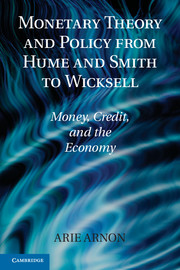Book contents
- Frontmatter
- Dedication
- Contents
- List of Illustrations
- List of Tables
- Preface
- Introduction
- Part one Analytical and Historical Foundations
- 1 Monetary Theory circa 1750David Hume
- 2 Mid-Eighteenth-Century British Financial System
- 3 Adam SmithThe Case for Laissez-Faire in Money and Banking
- 4 “Monetary Theories of Credit” in Exchange
- Part two Debating Monetary Theory under Inconvertibility
- Part three Debating
- Part four The Road to Defensive Central Banking
- Part five A New Beginning
- Bibliography
- Author Index
- Subject Index
1 - Monetary Theory circa 1750David Hume
Published online by Cambridge University Press: 05 July 2014
- Frontmatter
- Dedication
- Contents
- List of Illustrations
- List of Tables
- Preface
- Introduction
- Part one Analytical and Historical Foundations
- 1 Monetary Theory circa 1750David Hume
- 2 Mid-Eighteenth-Century British Financial System
- 3 Adam SmithThe Case for Laissez-Faire in Money and Banking
- 4 “Monetary Theories of Credit” in Exchange
- Part two Debating Monetary Theory under Inconvertibility
- Part three Debating
- Part four The Road to Defensive Central Banking
- Part five A New Beginning
- Bibliography
- Author Index
- Subject Index
Summary
Introduction
David Hume’s (1711–1776) writings on economics are found primarily in the collection of essays published in 1752 as Political Discourses. As we will see, this relatively short work became a benchmark analysis in later years; references to Hume’s monetary theory appear repeatedly in later discussions of monetary issues. Hence, Hume’s monetary theory and the analytical framework he used are natural starting points for our journey into the debates concerning monetary theories. Although many scholars who have studied the subject (Viner [1937], Rist [1940], Schumpeter [1954]) agree that none of the major analytical tenets of Hume’s thought constitute a “discovery” but rather could be found among the writings of others at the time; the impact of his monetary ideas and the unique position that they came to assume are beyond doubt. This is probably due both to Hume’s other major achievements as a philosopher and historian and to the comprehensive character of his economic formulations. Most important, Hume’s monetary theory distanced him from the Mercantilist perspective on money, which was still very influential in the mid-eighteenth century; he clearly contributed significantly to its decline.
The Mercantilists, as is well known, associated the wealth of a society with the stock of money it held. In particular, this school of thought held the view that not only were the precious metals a good measure for wealth, but also that accumulating a bigger stock of precious metals would serve to increase the wealth of a country. Hence, the Mercantilists supported policies that were intended to create a surplus in the balance of payments; the resulting surplus was supposed to be maintained consistently over time. The comprehensive interventionist measures that the Mercantilists advocated, with a view to achieving surpluses, culminated in a set of policies directed at both internal economic affairs and external trade (for a review of Mercantilism, see Angell [1926], Viner [1937], and Magnusson [1994], as well as many references therein).
- Type
- Chapter
- Information
- Monetary Theory and Policy from Hume and Smith to WicksellMoney, Credit, and the Economy, pp. 9 - 25Publisher: Cambridge University PressPrint publication year: 2010

